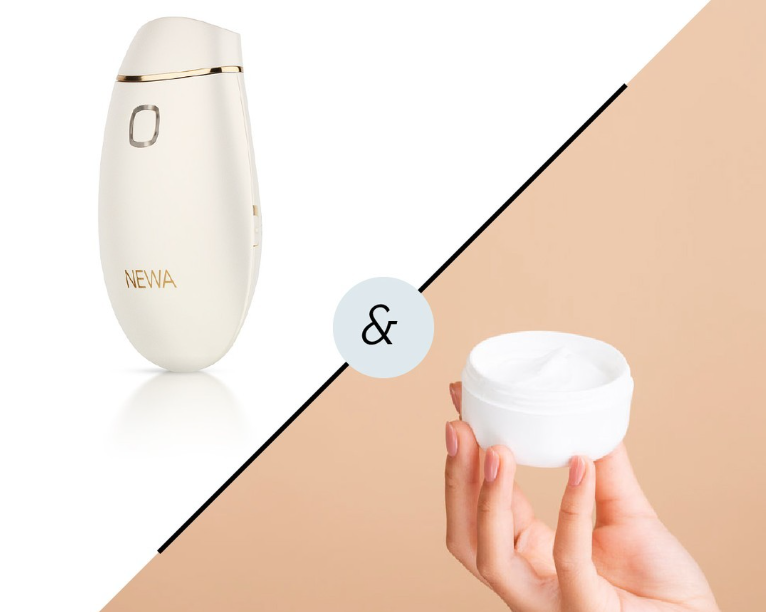Have you been feeling like your skincare products aren’t doing enough to address aging skin? We’ve got two products today to elevate results for the person who has a skincare routine in place but wants to better address concerns like sagging skin, age spots, and fine lines and wrinkles.
We’re going to be talking about why resurfacing the skin and collagen induction can be such an effective combo for more radiant, firm skin.
Skin Aging

Now, let’s clear something up first. Chronological aging is a natural - and inevitable - process. We’re all slowly getting older with each passing second and with that comes the experience and perspective that only time can offer. There is no miracle cream to halt the passage of time and we don’t believe in treating aging like a bad word. While “anti aging” may be the term used to describe products and treatments for aging skin, it fails to properly describe how they work or any of the positives that come with getting older.
Our skin is unique, though. Because it’s our most superficial organ system and serves as a protection against our environment, much of skin aging is not due to internal factors. Instead, it’s externally caused which is called photoaging. The “photo” in the name is due to the primary cause of premature skin aging - sun exposure. Now if it’s too late to prevent and you’re noticing signs of aging, there are proven interventions to help repair this damage. It’s just important to understand that we are primarily targeting aging that is avoidable.
Unfortunately, aging of other tissues like the facial fat pads and bones aren’t as easily prevented or addressed. Skincare and devices largely target the skin - and usually just the top layer of the skin, the epidermis. Proven interventions for sagging due to facial fat loss typically involve seeing a provider for treatments like filler. But let’s end on a positive note. While we can’t prevent chronological aging, menopause is one of the contributors and we can address some of its effects on the skin.
The Skincare Routine

The last topic we have to discuss before jumping into our suggestions is the skincare routine. This is your foundation to both skin health and preventing premature aging. As this blog is designed for the advanced skincare user, it’s important that you have a solid routine in place first. At the end of the day, even the most effective treatments can’t make up for not having a daily routine.
Building a skincare routine should start with the basics. You’ll want a cleanser, moisturizer, and sunscreen that are suitable for your skin type. If you’re having trouble figuring out your skin type, Dr. Leslie Baumann has helped expand research on skin type and has one of the only evidence based skin type quizzes. These basic steps are all designed about skin health and protection. Without them, other more targeted steps could make the skin more photosensitive or cause more irritation than needed.
Build upon your routine by targeting skin concerns. Once you have the basics, then you can begin to target the concerns you wish to address and make progress on your goals. Retinoids like tretinoin are the “gold standard” when it comes to topical ingredients for skin aging. Antioxidants like ascorbic acid and niacinamide also have some evidence. If you’re noticing dark spots due to sun damage, you can discuss a pigment inhibitor like hydroquinone with your dermatologist.
If skincare alone isn’t cutting it, it can because many skincare ingredients don’t target the deeper skin layer (the dermis) and address the loss of collagen and elastin. And even in the epidermis, sun damage and other concerns like hyper pigmentation can be very stubborn. So what next?
Tip 1: Add Radio Frequency Skin Tightening

The first one may come as no surprise but let’s recap. As we get older, collagen levels in the dermis of the skin decline at a rate of about 1% per year for the average adult woman. This will increase as we get older with the American Academy of Dermatology stating that “women’s skin loses about 30% of its collagen during the first five years of menopause.” If you’ve gotten a lot of sun exposure growing up or you’re noticing faster skin aging, you may have thinning skin that isn’t easily addressed with topical skincare.
Using the same 3DEEP technology as our professional ENDYMED machines, our NEWA devices (like our popular NEWA Classic) have been shown in clinical studies to improve collagen and elastin in the skin. With 3 months of consistent use, you can address about 4 years of collagen loss.
In addition to skin firming and the long term results, you’ll also notice a temporary skin tightening effect with each use as the heat from the treatment contracts the dermal fibers. This makes NEWA a great facial for special occasions or when your skin needs a pick-me-up.
Tip 2: Add Glycolic Acid

Our second tip is to look at adding glycolic acid to your skincare treatment as a weekly or monthly treatment. This alpha hydroxy acid is one of the most studied chemical peels for photoaging but if you’re not able to see a professional, there are lower strength formulations for safe at-home use. Contrary to popular belief, skin has its own exfoliation process called desquamation and many people don’t need an exfoliant daily - especially if you’re using a retinoid or keeping skin hydrated as these aid in the skin’s own shedding process. Glycolic acid can instead be used infrequently to target photodamage or other stubborn concerns.
While NEWA is targeting the deeper skin during your treatment days, glycolic acid can help with resurfacing and improving photodamage, hyper pigmentation, and roughness . And there is some early evidence showing that targeting both skin layers may be particularly effective. While much of the research on glycolic acid is on chemical peels, there is research showing results can still be achieved with lower concentrations at a safer pH level. A study on women using a 15% glycolic acid cream alongside topical estrogen therapy showed better results using them together while another showed good results with 8% glycolic acid.
While these products are formulated with the consumer in mind and for home use, we do want to stress that this is a suggestion for more advanced skincare users. And even if you’re experienced, we recommend the following:
- It’s important to start with a gentle glycolic acid product and begin slowly. Someone with hydrated skin or who is using a retinoid may not need regular exfoliation and you can use every 1-2 weeks to get the additional benefits from glycolic acid.
- If you’re unsure if glycolic acid is suitable for you or which product would be appropriate, please see a skincare professional. If you’re new to exfoliants, they may suggest you begin as low as 2-5% once a week or suggest an alternative more suitable for sensitive skin (like an enzyme cleanser).
- Don’t use it on the same night as your NEWA or any other treatment that is exfoliating or works via micro injury. You don’t want to overwhelm your skin or experience irritation.
Enjoyed this post? We have previous blogs on the benefits of using NEWA treatments alongside ingredients like hyaluronic acid and Vitamin C in your skincare routine.
Want to keep up with us or have a topic for a future blog? Message us on Instagram or join the NEWA Beauty Facebook Community. This blog is not intended to diagnose or treatment nor should it be used instead of seeking medical advice.




